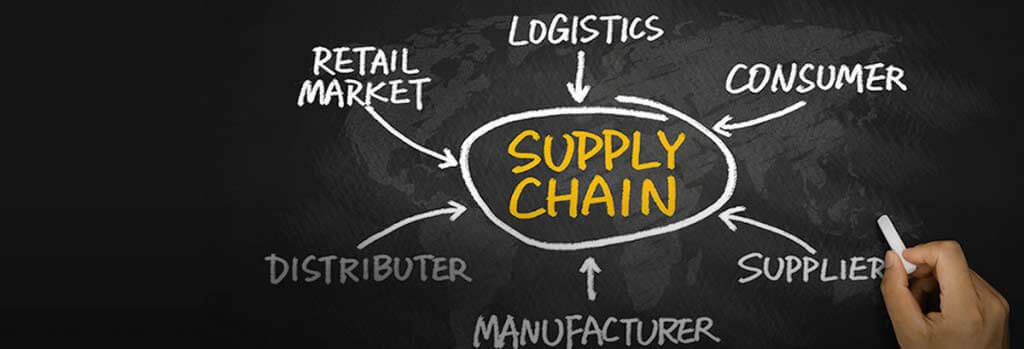
What is Supply Chain Management?
To begin with, the supply chain is not any business function. It’s a network of companies. Supply chain management involves implementing cross-functional relationships with suppliers and key customers in the network. It’s a new and important business model imperative for a company’s success where every function must be involved.
Over the past few decades, most of the companies in sectors like high tech to automotive, retail to consumer goods have realized that a supply chain involves more cost than getting the products in the hands of their customers. They seem to have finally realized that it’s the supply chain management that translates corporate strategies into day-to-day actions inside and beyond the company. It’s the supply chain system that ultimately satisfies or disappoints the customers. The companies prefer to use a broader supply chain definition: one that involves information sharing, planning, and value additions to activities, right from raw materials to the final distribution, and not just the logistics.
The best companies critically continue evolving and reinventing their supply chains, regardless of their position in the market. In this way, these companies manage risks better, respond to any change in the technological, economic, and competitive environment, and exploit fresh opportunities far more efficiently way than their peers.
Supply Chain Management – A Management Priority
Many senior executives have told us supply chain management issues have started to demand their attention increasingly. Nevertheless, achieving a supply chain distinction is getting more difficult by the day. Manufacturing and distribution networks have become more complex. But their successful operation is imperative for revenue generation and profitability. Risks in the supply chain system, at the same time, have increased. Improved transparency is thus critical to coordinate effective responses. Making the supply chain system work at its best requires robust cross-functional control and correct decisions across all verticals. More importantly, the correct supply chain system plays an important role in allowing companies to exploit the emerging opportunities to bolster growth and profitability.
The following three examples will explain what difference a highly functional supply chain management system can make.
A leading manufacturer of packaged consumer goods uses a supply chain management system to manage the input price volatility. The company has created several formulae and supply chains for a brand of home and industrial cleaning products. Determining the prevalent market price of ingredients, the company switches between the formulae and supply chains. This allows the company to hedge against the increasingly unstable raw material prices.
The second company, a market leader in cosmetics, has set up a fast and specialized supply chain system for its new products. The system, which gives incentives only on time for marketing and product launching excellence, enables the company to reach the latest products to the hands of the customer, ahead of its competitors. Meanwhile, its traditional supply chain system controls the cost of products that already have a steady demand.
Or consider the burgeoning online retail market, which is transforming consumer expectation of product availability and delivery time. The online market in China could be a nice example in this regard. Companies like GOME Electrical and Suning Commerce Group, two major players in the el
electronics market, deliver their products within hours of placing an order to customers in big cities. The speed of delivery has now become a major necessity because customers are increasingly ordering the exact similar item from other retailers. The equation is simple, take the one which is delivered first. Reject the others.
Nine Strong Interventions
If the above examples mean anything, it’s the ways in which a supply chain system can steer business performance. But when we actually think of supply chain optimization, we typically think to improve delivery time and accuracy and customer service. Many companies, sadly, fail to understand that smarter supply management can generate hidden savings. Most of them fail to link financial information and the logistics process and miss out on revenue.
We have identified the following actions that the top management can adopt for maximizing the supply chain system’s potential for their company.
1. Inventory management
Let’s say you have only a two-hour worth of sitting stock in your car manufacturing unit, with an aim to keep the storage costs low. But what will happen when a particular part of your cars, say headlights, are delivered an hour late? It could lead the tightly coupled production line to come to a standstill. So what are the delay costs that you have to factor in? Focusing solely on limiting stock is a myopic strategy, and in terms of your bottom line, the result is likely to be incurring more costs than the revenue it brings in. Organizations have to strike the correct balance between minimizing their stock and the stomach to meet customer demands. Threats to stock shortage must be contemplated well in advance before it actually strikes. Remember, you can say “no” to your customer only if the crisis is really big.
2. Improve your distribution network
The distribution network of your company is the operational fulcrum around which your supply chain management system is built. Distribution affects everything, including sales strategy and delivery tracking. Improving the distribution network should be your main aim, which you can do with a cluster view or a holistic approach. In the latter, you have to review the essential parts of your distribution network and figure out how they work in tandem. For instance, look at the purchasing software and to see how it works with the delivery system. Does it communicate well with the warehouse manager and production foreman? If it’s not as efficient as you like it to be, identify the areas where the changes should be incorporated. On the other hand, the cluster view groups graphs, charts, and other details together and helps to keep watch on the process for a specific company function.
3. Devise a distribution strategy
A good distribution strategy is integral to the supplier management framework. It reduces product decay while improving the customer service. The broader field of supply chain management can help an organization plant seeds for long-term financial stability. Supply chain management experts Frank F Britt, Donavon J Fabre, and David L Anderson have indicated that devising a good blueprint for distributing your products and services will help in achieving profitable growth, particularly when corporate managers strategically think about cost revenue and asset utilization.
While making your distribution strategy, keep a close watch on issues like production facilities, cross-docks, warehouses, and above all, customers, along with the number, location and the network of suppliers. Set a proper goal for your distribution. Put in place tactics in sync with your overall supply chain strategy. For instance, if you want to get an industry award for timely delivery, find out all major stakeholders, i.e. production supervisors, delivery teams etc., for the essential process to improve.
4. Segregating your corporate and supply chain strategies
Whether your business strategy involves product innovation, superior service, or cost leadership, always ensure that the supply chain plays its role in delivering the key points of the strategy. Fetch leaders from all sections of your business to a common platform for defining the supply chain management system which would work for you. Make sure they give the data that NXT Point 3p logistics company and your organization have to deliver. The marketing section would tell you what the customers demand most from you and how they vary. What will set you apart from your peers? Your company’s commercial functions must identify the customers who justify the best service price, which can be served better using a greater standardized approach. Your manufacturing functions and supply chain system must find ways to come up with innovative products or services that cater to the demands of all customers, and at the same time, keep the costs under control. In the realm of distribution, particularly for businesses utilizing direct store delivery models, this principle of innovation and cost control is equally vital. To optimize these operations, direct store delivery route accounting software becomes indispensable. It not only aids in managing the financial aspects of deliveries but also improves route efficiency, reduces fuel costs through optimized routes, and minimizes product waste by tracking inventory in real-time.
5. Supplier cash control
You can find great insights into your supply and payment contracts with suppliers. There are several elements to consider, including how to avoid buying unnecessary stock (via automated order processing), avoiding costs for correction in both orders and supplies and optimizing the payment behavior of suppliers. Partnerships with vendors usually contain many automatic processes that should be analyzed and optimized carefully.
6. Controlling operational expenses
In many companies, there’s a great deal to improve on the operational side of things. There could be reasons for incorrect supplies. Instead of just correcting the relevant order, it’s imperative to search for the particular point in the process where the discrepancy arose to prevent the recurrence of the same mistake.
7. Creating a modern supply chain organization
Managing the supply chain in discrete tiers is a dated process. Sophisticated data analyses have now enabled organizations to manage supply chains end-to-end. In industries like retail, this happens almost in real-time. A single leader can be responsible for such performance and deliver improvement projects across various tiers and carry out traditional functions like manufacturing, marketing, and procurement. Ensure that the supply-chain system merges operational excellence with a strong analytical capability and data-driven, multifunctional decision making. Set up analytical teams for supporting the decision making and identifying hidden opportunities and risks in unstructured data. Always ensure that your information technology function supports them with platforms and applications that facilitate collaboration as well as analytical decision making.
8. Customer cash control
While improving the profitability of customer relationships and orders, it’s important to measure order processing and to optimize the settlement of payments. You have to constantly measure whether the right product is delivered to the right place in the right quantity as desired by the client. Supply processes can be optimized to avoid expensive errors. Settling payments with clients is one factor which is equally important for saving costs. Reducing the time between orders and payment, resolving late payments, making a missing payment visible and invoicing them can greatly reduce costs.
9. Set performance benchmarks for your company
Give incentives to the supply chain organization for working in ways which would deliver the biggest value for your company, and at the same time, secure against the biggest risks. It means resorting to more than the conventional metrics of capital, cost, and service. The key performance indicators (KPIs) strongly depend on the demands of the business and the product or service, and the particular market segment. These include the production cost for value players, stable supply of critical products and staple items, agility to deal with fluctuating demand in volatile markets, and the perfect launch of a new product is essential. When a particular metric doesn’t matter to your business, don’t forcibly impose it upon your organization.
Conclusion
In order to realize the real improvements to a supply chain, it’s important that logistics experts and controllers work more closely together. In several companies, optimization of the supply chain management system is considered largely from the logistical point of view, sans looking into the exact economic consequences of some decisions.
With a simple analysis, it’s clear that a company can gain much in a quick time. But most companies, unfortunately, still miss out on a lot of opportunities because they don’t have the full picture in front of them, nor do they think in a detailed manner. If you want to realize the actual savings, you must calculate the effect of carrying out changes in your supply chain management system on operational costs, service provision, working capital, and, most importantly, the revenue of the company. Only then you can possibly determine to what extent supply chain optimization will truly trigger your profits.
Recommended Articles
This has been a guide to Supply Chain Management. Here we have discussed the basic concept, 9 Strong Interventions. You may look at the following articles to learn more –





